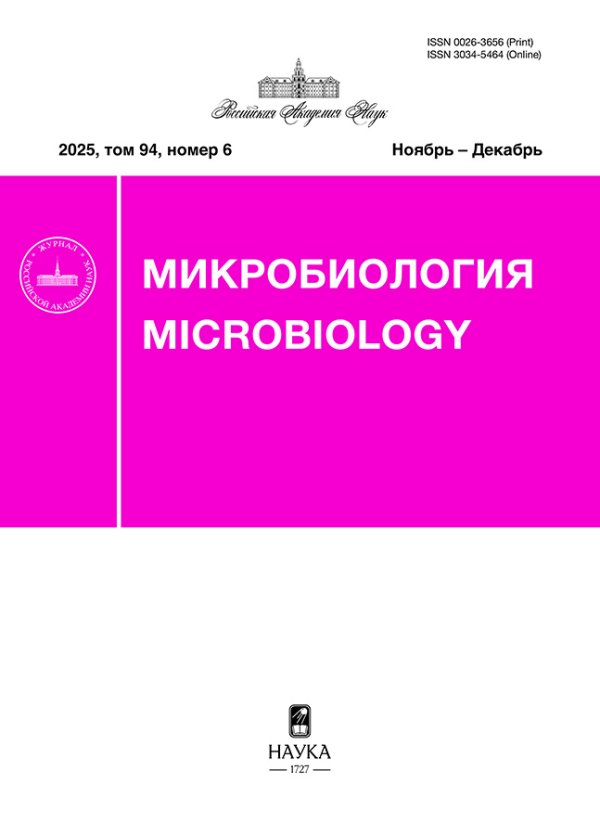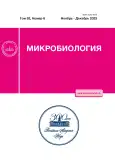Occurrence of the Ability to Suppress the Growth of Related Strains in Rhizobia
- Authors: Baymiev A.K.1, Vladimirova A.A.1, Matniyazov R.T.1, Lavina A.M.1, Filyaeva .Y.1, Akimova E.S.1, Baymiev A.K.1
-
Affiliations:
- Institute of Biochemistry and Genetics, Ufa Research Center, Russian Academy of Sciences
- Issue: Vol 92, No 6 (2023)
- Pages: 625-630
- Section: EXPERIMENTAL ARTICLES
- URL: https://journals.rcsi.science/0026-3656/article/view/231919
- DOI: https://doi.org/10.31857/S0026365623600311
- EDN: https://elibrary.ru/BSITVE
- ID: 231919
Cite item
Full Text
Abstract
Abstract—
Screening of 1019 strains of rhizobia Rhizobium leguminosarum and Neorhizobium galegae from the “Symbiont” collection of symbiotic rhizospheric microorganisms of the Institute of Biochemistry and Genetics, Ufa Research Center, Russian Academy of Sciences, which have been isolated from root nodules of 20 leguminous species, for the ability to suppress the growth of related strains of rhizobia was carried out. Inhibition of the growth of competing bacteria by rhizobia was shown to be rather common. On average, when grown on rich media, ~10% of rhizobial strains released antibacterial substances into the medium. At the same time, when a live culture of rhizobia was applied to the lawn of bacteria, the percentage of suppression was higher. The percentage of strains synthesizing antibacterial substances correlated also, to some extent, with the level of genetic diversity of the population of legume microsymbionts. A weak signal of impaired protein synthesis was found in the study of the mechanism of action of metabolites of 20 strains of rhizobia R. leguminosarum bv. viciae from root nodules of Lathyrus palustris and Lathyrus vernus. In other cases, the nature of the antibacterial action of bacterial metabolites could not be determined using the DualRep2 system.
About the authors
Al. Kh. Baymiev
Institute of Biochemistry and Genetics, Ufa Research Center, Russian Academy of Sciences
Author for correspondence.
Email: baymiev@mail.ru
Russia, 450054, Ufa
A. A. Vladimirova
Institute of Biochemistry and Genetics, Ufa Research Center, Russian Academy of Sciences
Email: baymiev@mail.ru
Russia, 450054, Ufa
R. T. Matniyazov
Institute of Biochemistry and Genetics, Ufa Research Center, Russian Academy of Sciences
Email: baymiev@mail.ru
Russia, 450054, Ufa
A. M. Lavina
Institute of Biochemistry and Genetics, Ufa Research Center, Russian Academy of Sciences
Email: baymiev@mail.ru
Russia, 450054, Ufa
K. Yu. Filyaeva
Institute of Biochemistry and Genetics, Ufa Research Center, Russian Academy of Sciences
Email: baymiev@mail.ru
Russia, 450054, Ufa
E. S. Akimova
Institute of Biochemistry and Genetics, Ufa Research Center, Russian Academy of Sciences
Email: baymiev@mail.ru
Russia, 450054, Ufa
An. Kh. Baymiev
Institute of Biochemistry and Genetics, Ufa Research Center, Russian Academy of Sciences
Email: baymiev@mail.ru
Russia, 450054, Ufa
References
- Баймиев Ан.Х., Иванова Е.С., Птицын К.Г., Белимов А.А., Сафронова В.И., Баймиев Ал.Х. Генетическая характеристика клубеньковых бактерий дикорастущих бобовых Южного Урала // Мол. генет. микробиол. вирусол. 2012. Т. 27. С. 29‒34.
- Baimiev An.K., Ivanova E.S., Ptitsyn K.G., Belimov A.A., Safronova V.I., Baimiev Al.K. Genetic characterization of wild leguminous nodular bacteria living in the South Urals // Mol. Genet. Microbiol. Virol. 2012. V. 27. P. 33‒39.
- Baba T., Mori H. The construction of systematic in-frame, single-gene knockout mutant collection in Escherichia coli K-12 // In Microbial Gene Essentiality: Protocols and Bioinformatics / Methods in Molecular Biology: Humana Press, 2008. P. 171–181.
- Fuqua W.C., Winans S.C., Greenberg E.P. Quorum sensing in bacteria: the LuxR-LuxI family of cell density-responsive transcriptional regulators // J. Bacteriol. 1994. V. 176. P. 269–275.
- Hirsch P.R. Plasmid-determined bacteriocin production by Rhizobium leguminosarum // J. Gen. Microbiol. 1979. V. 113. P. 219–228.
- Lethbridge B.J., Asenstorfer R.E., Bailey L.S., Breil B.T., Johnson J.V., Jones G.P., Rumjanek V., Sims J.J., Tate M.E., Triplett E.W. Post translational modifications of Trifolitoxin: a blue fluorescent peptide antibiotic // J. Antibiotics. 2022. V. 75. P. 125–135.
- Osterman I.A., Komarova E.S., Shiryaev D.I., Korniltsev I.A., Khven I.M., Lukyanov D.A., Tashlitsky V.N., Serebryakova M.V., Efremenkova O.V., Ivanenkov Y.A., Bogdanov A.A., Sergiev P.V., Dontsova O.A. Sorting out antibiotics’ mechanisms of action: a double fluorescent protein reporter for high-throughput screening of ribosome and DNA biosynthesis inhibitors // Antimicrob. Agents Chemother. 2016. V. 60. P. 7481–7489.
- Schwinghamer E.A. Properties of some bacteriocins produced by Rhizobium trifolii // J. Gen Microbiol. 1975. V. 91. P. 403‒413.
- Schwinghamer E.A., Brockwell J. Competitive advantage of bacteriocin and phage-producing strains of Rhizobium trifolii in mixed culture // Soil Biol. Biochem. 1978. V. 10. P. 383–387.
- Schwinghamer E.A., Pankhurst C.E., Whitfeld P.R. A phage-like bacteriocin of Rhizobium trifolii // Can. J. Microbiol. 1973. V. 19. P. 359‒368.
- Travin D.Y., Jouan R., Vigouroux A., Inaba-Inoue S., Lachat J., Haq F., Timchenko T., Sutormin D., Dubiley S., Beis K., Moréra S., Severinov K., Mergaert P. Dual-uptake mode of the antibiotic phazolicin prevents resistance acquisition by gram-negative bacteria // mBio. 2023. V. 14. P. e00217‒23.
- Travin D.Y., Watson Z.L., Metelev M., Ward F.R., Osterman I.A., Khven I.M., Khabibullina N.F., Serebryakova M., Mergaert P., Polikanov Y.S., Cate J.H.D., Severinov K. Structure of ribosome-bound azole-modified peptide phazolicin rationalizes its species-specific mode of bacterial translation inhibition // Nat. Commun. 2019. V. 10. P. 4563.
- Triplett E.W., Barta T.M. Trifolitoxin production and nodulation are necessary for the expression of superior nodulation competitiveness by Rhizobium leguminosarum bv. trifolii strain T24 on clover // Plant. Physiol. 1987. V. 85. P. 335‒342.
Supplementary files















